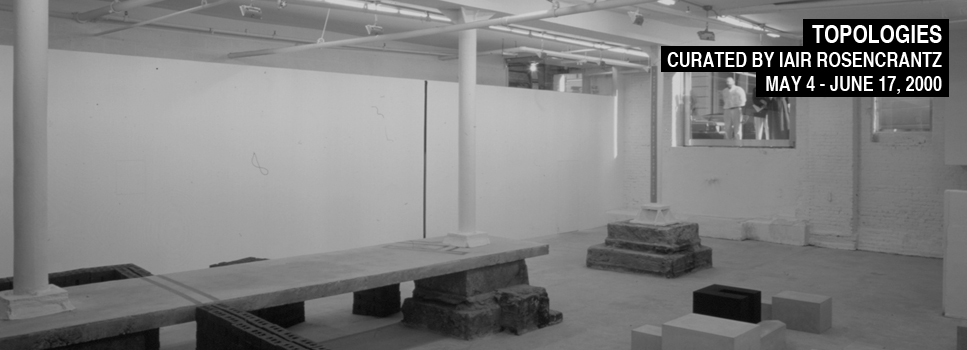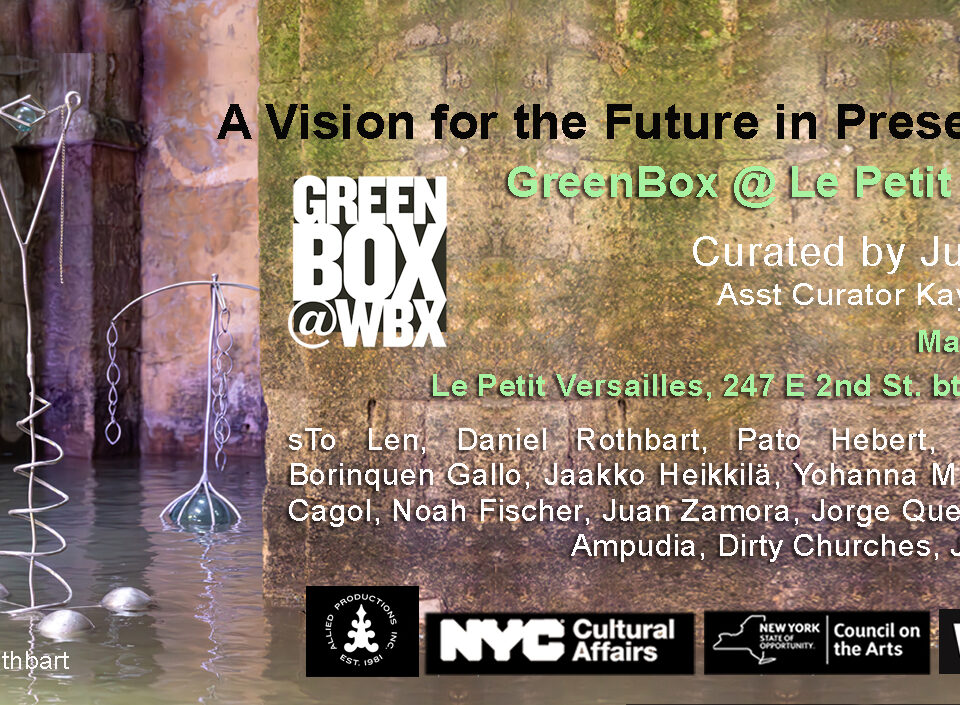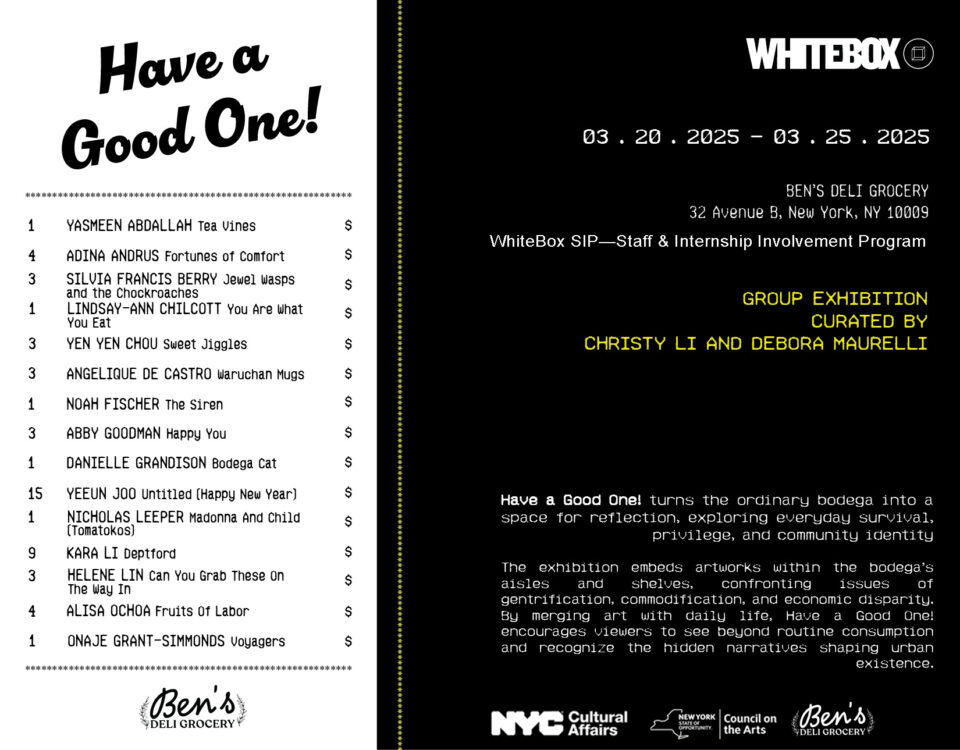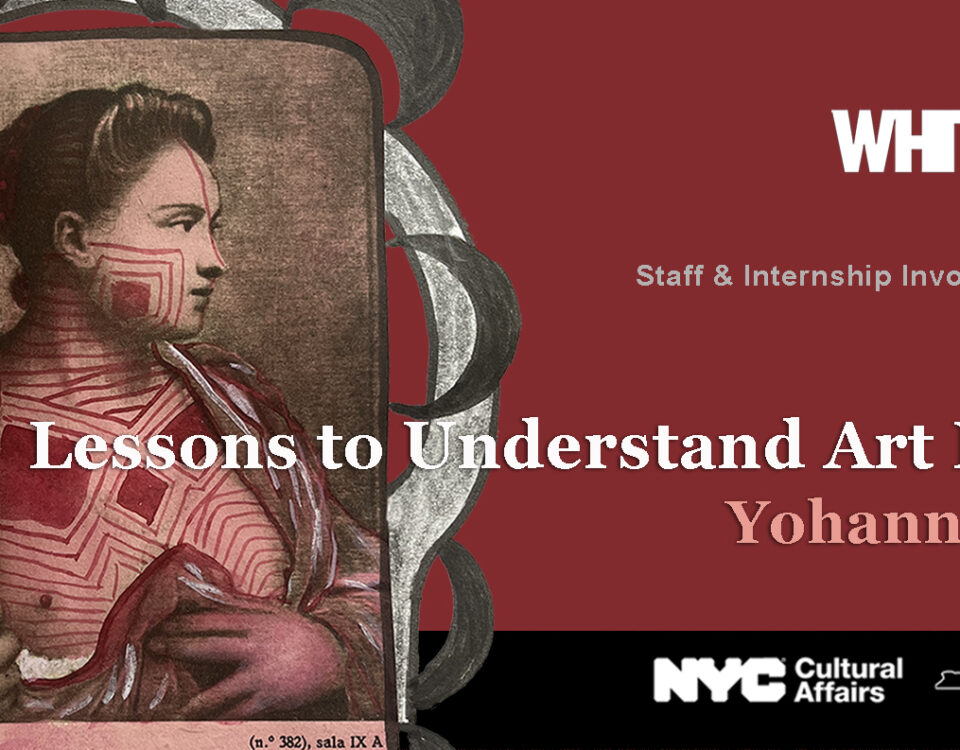TRANSLATION / SEDUCTION / DISPLACEMENT
February 3, 2000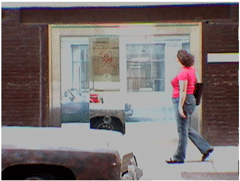
SIX FEET UNDER
July 6, 2000Curated by Juan Puntes and the artists in Collaboration with Galerie Heike Curtze of Vienna – October 7, 1999
October 7 – December 18, 1999
Topologies elaborates on the demystification of the symbiotic relationship between art and architecture. The exhibition complements the design process as topological investigations through site specific interventions by artists who explore the notions of space. Six artists explore the subject from different points of view. The use of gravity with the assemblage of objects on the floor (Barry Le Va), wall interventions as deconstruction (William Anastasi), wall as a transparency through video projections (Maria Marshall), the symbolic realm of space (Osvaldo Romberg), text as defining thus activating space (Lawrence Weiner), and the immateriality of sound to define an experience of progression (Shelley Hirsch).
William Anastasi Incision (1966-2000) and Untitled (One gallon of industrial high-gloss enamel, poured) (1966-2000)
Shelley Hirsch Your Neighborhood (2000)
Barry Le Va Family (A to A, B to B) – partially accounted for (1989)
Maria Marshall I’m not going to die easily (1999)
Osvaldo Romberg Red Macchu Picchu (2000)
Lawrence Weiner A MOUND OF THOSE OFFERINGS THAT HALLOW LAYING WASTE & MAKING FALLOW A PORTION OF THE LAND (1997)
PRESS
Publication: Octogon
Writer: Thomas McEvilley
“Topology”, read by way of its Greek roots, means “logic of place”, or “analysis of space”, or something similar. The fact that the title of the opening exhibition of White Box is plural, “topologies”, implies different types of “logic of place” or “analyses of apace” are overlaid on one concrete location. The concept implies something like different realities coexisting in one realm (different topologies in one white box), different projections of meaning overlaid on a single undifferentiated foundation, various multi-perspectival focuses on a single objective realm. But then the inevitable question rises: Is there really a concrete substrate of actual space/place underneath the layers of cognitive or emotional projections? Or are there only the projections, sustained, like images floating in the air, by our belief in them?
The idea of Place with a capital p recalls the theological idea of a Center or Navel or Connection Point whence a channel goes to the Beyond. Such a Place might belong in Plato’s realm of Ideas. But the actual or concrete place is not conspicuously archetypal; it’s just a place one walks into off the street, from the rainy or breezy or otherwise textured world outside. Inside the white box there is a quieter and more reflective space cryptically inscribed with various differing topologies like a series of drawings on a transparent plastics sheets or a layering of chalk graffiti on a sidewalk.
This curatorial agenda expresses the nature of the exhibition space that the show inaugurates. It is not this type of space or that type of place—it is, rather, an alternative space—alternative involving Otherness—a space other than any recognized and fixed conceptions of spaces or places. It is thus posited as undefined, as a zone somehow preceding definition, a pre-essential, existential space on which one conception or suggestion or another can be inscribed by anyone willing to take the responsibility of proposing a definition, stating a premise, laying down a challenge. In a sense there is a ladenness or saturation to the space that involves it in the idea of Center, but internally its layering of various topologies puts it in a shifting field of complexification where the idea of Center seems too simple. The artist’s works radiate around the little gallery in ambiguous multivalent ways that point in a variety of contradictory directions; as in the marvel of psychological projection, these contradictory forces can coexist due to the lack of definition at the foundation of it all.
Lawrence Wiener’s work has long related to architecture—to the idea of an enclosing structure around human behavior which tries to give meaning to it—and to architecture’s interaction with language, like the inscriptions over ancient temple doorways: “Nothing too much”, or, “The Uninspected Life Is Not Worth Living”. In the topology of his work, too, space declares itself as a place for linguistic significations to unfold, but rarely with a simple and clear meaning. His linguistic adornments, which relate to the architecture as ornamental sculpture used to, have often been subversive in the simplistic way of obstinately refusing to make sense within the structure which seems to be trying to bring a meaning to birth. In the present case his choice of an upright cylindrical column as the support for his phrases suggests a comment on the supporting pillars of the institution. As the institution is an alternative or hypothetical space, rather than any actual posited space, its supporting pillars become question marks, ambiguous suggestions of a stability that is not really there. So Wiener articulates space in terms of language, but without any particular ideological fixation
In the present work Wiener’s projection of meaning exceeds in some ways his custom, which can me illustrated by one classic example from 1974: “(Sometimes Found)/ Within the context of change: /Arranges as (to)/ Arranged as stot.” The reference system seems wholly abstract, hardly even concrete enough to refer explicitly to space in the broadest sense: through the arrangement of things in space seems possibly to be the referent, it may be a purely cognitive process referred to, a topology of a purely mental space. The emphasis on punctuation devices involves various witty subtleties that are absent from the text of the present work. “A mound of those offerings that hallow”, says this text, “Laying waste and making fallow a portion of the land”. It’s an unusual text for Wiener in several ways. First in involves rhyme, a gesture of homage to poetry rather than to the more coolly analytic style of classical Conceptualism. Secondly, there are religious overtones hearing back to the myth of the Grail and the Waste Land. References to the outdoor mix with hints of fertility religion. Finally, as a comment on the actual location of the white Box, it suggests that when an area of space is withheld from the regular flow of life for special art events, the space, by being redefined in this way, is both laid waste—stripped of meaning—and rendered fallow-ready for new projections.
William Anastasi’s “Incision” is an upright rectangle (16 x 13-5/8 in.) “inscribed not merely onto the wall, but into it, to a depth of-”, with a utility knife. Related to Anastasi’s “Wall-removals” (in which the entire rectangle is removed down to the lathe of the plaster), the piece represents a trend in his work that began in 1966. Like the inclusion of Wiener, Anastasi’s presence involved White Box with the historical topology of classical Conceptualism. The “incision” is in the typical shape of a small painting, and occupies the wall at about the height where a painting would hang. This an related pieces form Anastasi’s opera participate in the deconstruction of painting that was a major theme of the Conceptualism of the 1960s and 70s. As a part of its de-constructive strategy it affirms the idea of the dematerialization of the art object that was in the air at that time. It affirms a topology of non-space, or absolutely ideal undefined space, like the alternative space posited by the gallery itself. Anastasi pointedly chooses to take something out of the gallery than introducing a new object into it. The work is about absence, removal, and negation, but not without a celebratory mood in the tradition of Duchamp and John Cage. “Pour” defines space in terms of natural flow, liquidity, an interface between solidity and dissolution between culture and nature, object and process. It might be described as showing end of the world happening on a small scale right before your eyes. Undifferentiated matter has undergone an ultimate meltdown in which feature and detail disappear. “Pour” places the idea of space into a kind of chaos which asserts a fundamentally lower or more basic meaning. It is not the meaning carried by architecture but the meaning that will erode and dissolve all the certainties of architecture and carry them away on the stream. Taoist ideas of water always seeking the lowest level, and thus signifying the opposite of the lofty ideals and ambitions of civilization (signified by architectures in durable materials) underlay the message of the piece.
Osvaldo Romberg often shows a space that is constructed purely of tradition. He celebrates the tradition of defining space as an ultimate or archetypal configuration. Related to architecture or the idea of an enclosing structure of meaning this work refers to the specific sites in the history of culture and religion, sites which have recently wandered from the Gothic age of Europe to other parts of the world. In the present show Romberg’s Red Machu Picchu recreates—or relocates—a detail of the ancient Peruvian site on the floor of White Box.
The low structure reflects the foundation walls of an archeological ruin and also Romberg’s preoccupation with the floor plans of sacred buildings. The level of root meaning is seen without the shifting superstructure, which is treated almost as if it were mere ornament—not even worthy to be seen.
As often in Romberg’s work, the underlying of the meaning of a cultural tradition is viewed at a hotspot- the intersection of religion, architecture, and a history of civilization in a broad sense. It is laid bare as an enduring foundation at one like that of an archeological ruin that leaves only the foundation and as a stripped down mannequin or maquette of root meaning. On the one hand there is an implied reference to something Mircea Eliade’s concept of ritualized space as Place, Center, navel or axis Mundi. But Romberg has de-centered the Center by shifting it out of the western world and searching through other cultures for uses of space which acknowledge its dignity with a reverent solemnity.
Barry Le Va’s approach to topology in Partially accounted for…combines several of these themes. Twelve blocks of six different geometric shapes like on the floor in a configuration that recalls his earlier scatter works but with less sense of natural randomness. On the one hand the work suggests a view like Anastasi’s in Pour in which nature is affirmed as a force or reality more fundamental than civilization yet not to be feared- a kind of set of constructivist building blocks. Yet Le Va’s work here suggests architectural ruins, as do Wiener’s and Romberg’s and thus carries with it an aura of melancholy that is lacking in Anastasi’s. The universe of ordered constructions seems to have been deconstructed or reduced back to its essential geometric underpinning, like the materials manipulated by the Demiurge in the Timataeus. The primary shapes on the floor (there are six different types of blocks) propose another approach to the idea of the primal place, the place where forms arise, where things happen to spring into being. Not like a place of Meltdown (like Anaximander’s Indefinite—or Anastasi’s “Pour”) this model is more like the Pythagorean-Platonic Place that is constructed out of regular geometric building blocks that operate like archetypes underlying the more obvious appearances of the world. The title suggests something inchoate, primal, not yet totally committed to this form or that. Le Va prepared the arrangement with a method of reading in mind whereby, through following the arrows and making various combinations, one arrives at fundamental gender distinctions and bodily structures, like the construction of a primal person or an anthropomorphic universe—again like that of Plato’s Timataeus. Shelley Hirsch defines the space of White Box sound waves, which don’t go through matter but bounce off of it. So, bouncing obediently down the hallways, they honor architecture, and recreate in their own body. In another sense the title, Your Neighborhood, like Wiener’s text, directs attention outside of White Box to the surround. Nine loudspeakers—six tweeters and three sub-woofers—are installed at both sides of the entrance ramp. Hirsch’s voice is heard articulating the phrase “your neighborhood” in various ways- higher and lower in pitch, with the phrases dismembered, extended, moved from mood to mood through screeches, operatic vocalizations, screams and so on. Reciprocating, the topology of “your neighborhood” flows from the outside into and through the interior of White Box. If one were to read the show as a single narrative, the silent topological models serve as an extended Proustian introduction to the scene and its fundamental ambiguities. Hirsch’s sound piece strikes up the overture, and Maria Marshall’s video at last puts the character into the space, the figure onto the complex and multifarious ground. Her brief video suggests a space based on the human body and its potential for movement- specifically the sideways extension of the arms and a minimalist sememe of raising them rhythmically up and down somewhat as if flying or suggesting flight. Marshall shows the human figure both occupying space with his or her bodily facticity and defining it facticity. The tradition of the Vitruvian figure suggests a metaphysical essence which in turn will define the space-indeed, the cosmos around it. But the simple facticity of the action in the space suggests, on the contrary, a more human fellow in all his ordinariness trying out the fit between his body and the space it inhabits, just checking it out, how far can I fling my arms, how at home can I feel in this world, and so on. The figure in the video is the closest thing in the show to a body with feeling-tones, to the theme of desire at the root of manifestation.
As the narrative unfolds, the movement of the figure can be seen to interact with the concreteness of the space, in which an earlier industrial era implied by the loading dock is now theorized as the erotic milieu of a catwalk. The fact of mercantile labor has been replaced by an erotic of desire. A dim nudity seems hinted in the darkness—though in a somewhat chase Old World way. The misty image of a human figure over the walkway as a distant memory and perhaps an anticipation. Yet underneath it, like the ground of a painting, the abstractness of the various analytic approaches to place eradicates the whiff of old nudity. Abstraction returns to a level which somehow seems even more basic than that of the desires and feelings of the body. This particularly layering of topologies does not amount to a romantic view, in which space is dripping with melancholy because of the sad things that must occur in it. There is not in fact much melancholy in this show. The thrust is conctructivist—“let’s build a world!”—rather than lamentational. There is a youthfulness and sense of early prime in the conception and the work that befits the coming into existence of a new space, its bowing sashay down the catwalk. And at the same time there is a cautious awareness of complexity and its Zenonian aporias.

